1993 CHEVROLET ASTRO PASSENGER steering
[x] Cancel search: steeringPage 97 of 345

Downloaded from www.Manualslib.com manuals search engine Your light switches are on the left side of the instrument panel above the
vent.
Press the top light switch
to the left to turn on:
Parking Lights
Taillights
License Plate Lights
Instrument Panel Lights
Press the bottom light switch to the left to turn on the headlights, together
with:
Parking Lights
Taillights
License Plate Lights
Instrument Panel Lights
Press both switches to the right to turn
off your lights.
Turn the dial above the light switches to the left
to dim your instrument panel
lights.
Turn the dial to the right to brighten your instrument panel lights.
If you turn
the dial all the way
to the right until it clicks, your interior lights will come on.
You can switch your headlights from high to
low beam by pulling on the
multifunction lever on the left of the steering column.
A circuit breaker protects your headlights. If you have an electrical overload,
your headlights will flicker on and
off. Have your headlight wiring checked
right away
if this happens.
2-41
Page 132 of 345

Downloaded from www.Manualslib.com manuals search engine Comfort Contmls & Audio Systems
Rear Air Conditioning
You may have rear air conditioning. The rear air conditioning switch is loca\
ted
above the radio at the top of the instrument panel. Slide the lever toward
HI
for cooler air in the rear area. Slide the lever to OFF to turn the system off.
If your vehicle has rear air conditioning, setting it on LOW may enhance front
NC performance by allowing trapped refrigerant in rear lines to circulate.
The system
will only send cooled air if the front system is on. It can still be
used
to recirculate air, even if the front system is off.
Before using the rear air conditioning, open the windows to cl\
ear the vehicle
of hot air. Close the windows when using the system.
Rear Window Defogger
HATCH REL REAR DEFOG
If your vehicle has this option the rear window will have lines \
running across
the glass. These lines heat your window.
For best results, clear the window of as much snow and ice as possible
before using the rear window defogger.
To turn on the rear window defogger, find the switch marked
Rear Defog on
your instrument panel to the left of the steering column. Press the top of the
switch until the light in the switch comes on, then release it. The rear window
defogger will only work when the ignition is in the
RUN position.
You can turn the defogger
off at any time by pressing the bottom of the
switch. The defogger will shut itself
off after several minutes so that the glass
3-8
Page 155 of 345
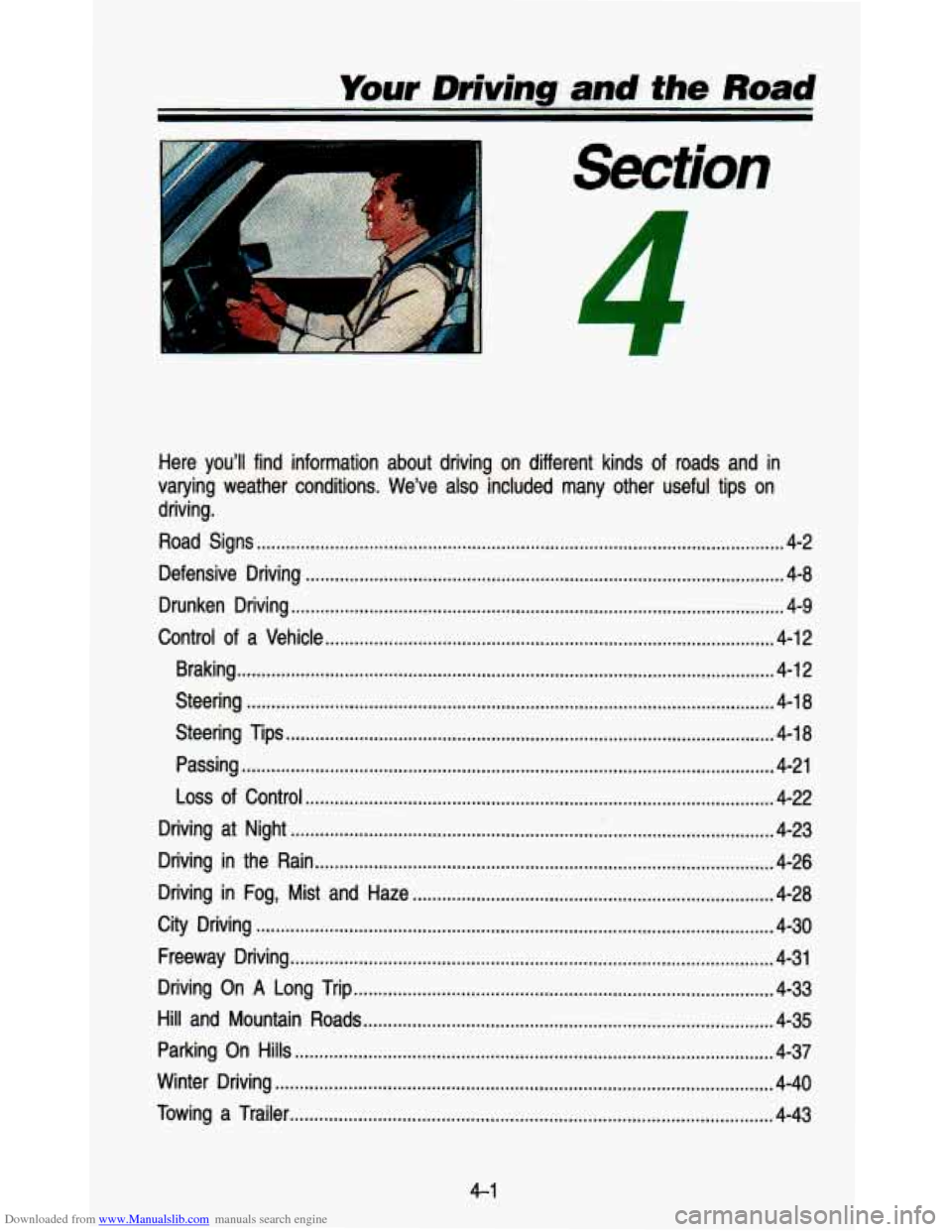
Downloaded from www.Manualslib.com manuals search engine Your Driving and the Road
Section
A
A
. 1
Here you’ll find information about driving on different kinds\
of roads and in
varying weather conditions
. We’ve also included many other useful tips on
driving
.
Road Signs ........................................................................\
.................................... 4-2
Defensive Driving ........................................................................\
.......................... 4-8
Drunken Driving ........................................................................\
............................. 4-9
Control of a Vehicle ........................................................................\
.................... 4-12
Braking ........................................................................\
...................................... 4-12
Steering ........................................................................\
.................................... 4-18
Steering Tips ........................................................................\
............................ 4-18
Passing ........................................................................\
..................................... 4-21
Loss of Control ........................................................................\
........................ 4-22
Driving at Night ........................................................................\
........................... 4-23
Driving in the Rain ........................................................................\
...................... 4-26
Driving in Fog, Mist and Haze ........................................................................\
.. 4-28
City Driving ........................................................................\
.................................. 4-30
Freeway Driving ........................................................................\
........................... 4-31
Driving On A Long Trip ........................................................................\
.............. 4-33
Hill and Mountain Roads ........................................................................\
............ 4-35
Parking On Hills ........................................................................\
.......................... 4-37
Winter Driving ........................................................................\
.............................. 4-40
Towing a Trailer ........................................................................\
........................... 4-43
4-1
Page 166 of 345
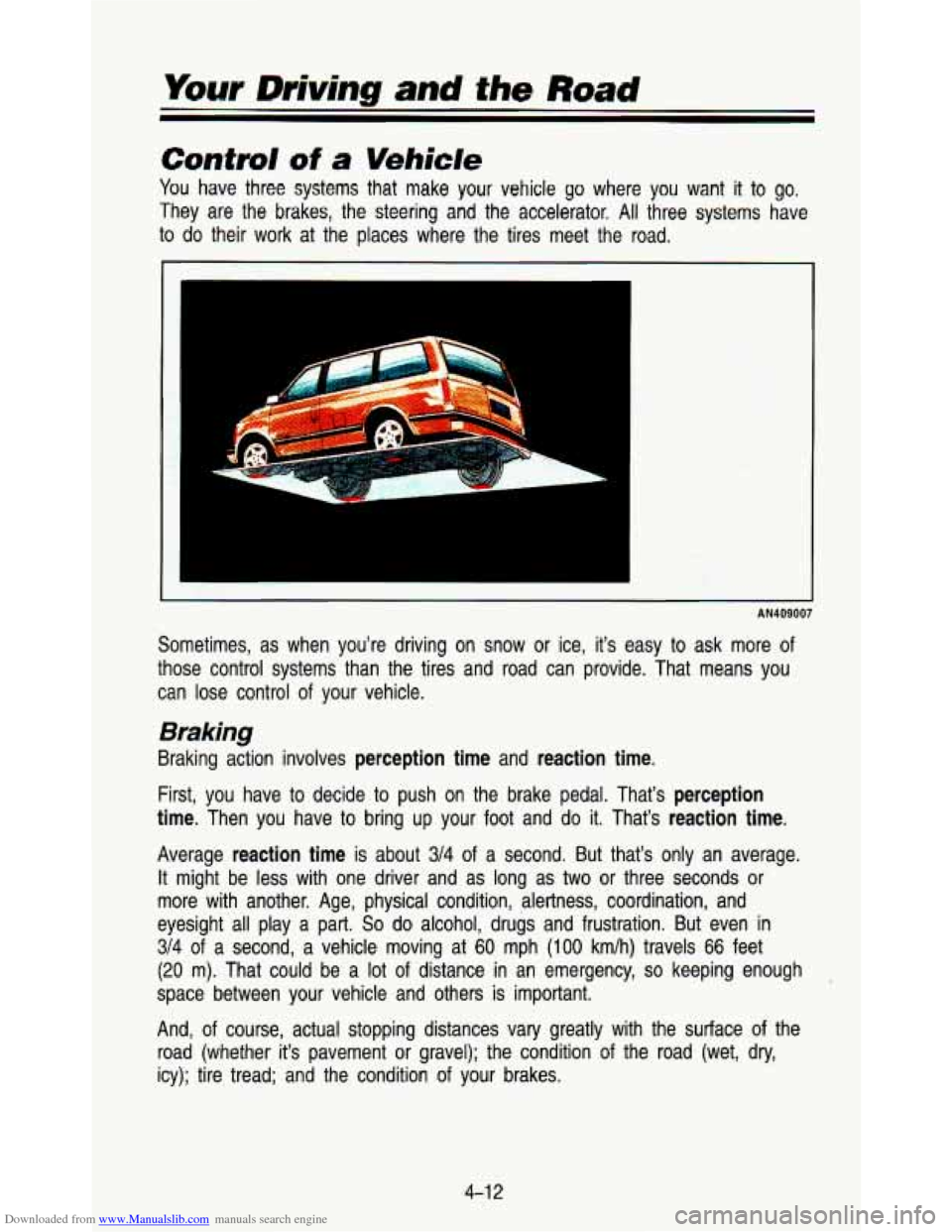
Downloaded from www.Manualslib.com manuals search engine Your Driving and the Road
Control of a Vehicle
You have three systems that make your vehicle go where you want it to go.
They are the brakes, the steering and the accelerator. All three systems have
to
do their work at the places where the tires meet the road.
f ’; 5
’. I
;::-;. I ?> - +. :
i: . ’. n --.
AN409007
Sometimes, as when you’re driving on snow or ice, it’s e\
asy to ask more of
those control systems than the tires and road can provide. Tha\
t means you
can lose control of your vehicle.
Braking
Braking action involves perception time and reaction time.
First, you have to decide to push on the brake pedal. That’s perception
time.
Then you have to bring up your foot and do it. That’s reaction time.
Average reaction time is about 3/4 of a second. But that’s only an average.
It might be less with one driver and as long as two or three seconds or \
more with another. Age, physical condition, alertness, coordinati\
on, and
eyesight all play a part.
So do alcohol, drugs and frustration. But even in
3/4 of a second, a vehicle moving at
60 mph (1 00 km/h) travels 66 feet
(20 m). That could be a lot of distance in an emergency, so keeping enough
space between your vehicle and others is important.
And, of course, actual stopping distances vary greatly with the surface of the \
road (whether it’s pavement or gravel); the condition
of the road (wet, dry,
icy); tire tread; and the condition of your brakes.
4-1
2
Page 172 of 345
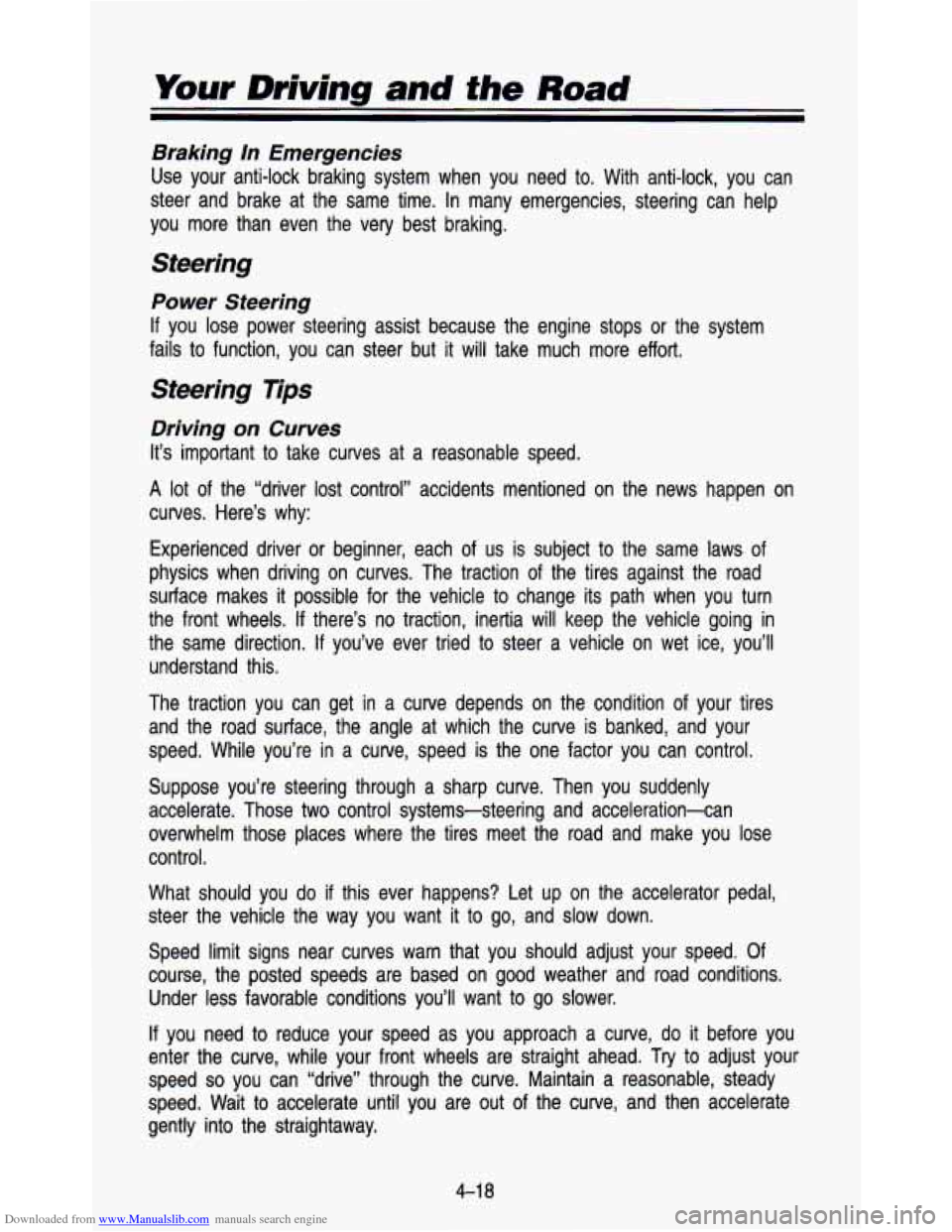
Downloaded from www.Manualslib.com manuals search engine Your Driving and the Road
Braking In Emergencies
Use your anti-lock braking system when you need to. With anti-\
lock, you can
steer and brake at the same time. In many emergencies, steering can help
you more than even the very best braking.
Steering
Power Steering
If you lose power steering assist because the engine stops or the\
system
fails
to function, you can steer but it will take much more effort.
Steering Tips
Driving on Curves
It’s important to take curves at a reasonable speed.
A lot of the “driver lost control” accidents mentioned on the news happen on
curves. Here’s why:
Experienced driver or beginner, each of us
is subject to the same laws of
physics when driving on curves. The traction of the tires against the \
road
surface makes it possible for the vehicle
to change its path when you turn
the front wheels.
If there’s no traction, inertia will keep the vehicle going in \
the same direction.
If you’ve ever tried to steer a vehicle on wet ice, you’ll
understand this.
The traction you can get in
a curve depends on the condition of your tires
and the road surface, the angle at which the curve is banked,\
and your
speed. While you’re in a curve, speed is the one factor you can control.
Suppose you’re steering through a sharp curve. Then you suddenly
accelerate. Those two control systems-steering and acceleration-can
overwhelm those places where the tires meet the road and make \
you lose
control.
What should you
do if this ever happens? Let up on the accelerator pedal,
steer the vehicle the way you want it
to go, and slow down.
Speed limit signs near curves warn that you should adjust your\
speed. Of
course, the posted speeds are based on good weather and road \
conditions. Under less favorable conditions you’ll want
to go slower.
If you need to reduce your speed as you approach a curve, do it before you
enter the curve, while your front wheels are straight ahead.
Try to adjust your
speed
so you can “drive” through the curve. Maintain a reasonable, steady
speed. Wait to accelerate until you are out of the curve, and\
then accelerate gently into the straightaway.
4-1 8
Page 173 of 345

Downloaded from www.Manualslib.com manuals search engine When you drive into a curve at night, it’s harder to see the road ahead of
you because
it bends away from the straight beams of your lights. This is
one good reason to drive slower.
Steering in Emergencies
There are times when steering can be more effective than braki\
ng. For
example, you come over a hill and find a truck stopped in your lane, or a
car suddenly pulls
out from nowhere, or a child darts out from between
parked cars and stops right in front of you. You can avoid these problems by
braking-if you can stop in time. But sometimes you can’t; there isn’t room.
That’s the time for evasive action-steering around the proble\
m.
Your vehicle can perform very well in emergencies like these. First apply your
brakes.
It is better to remove as much speed as you can from a possible collision.
Then steer around the problem,
to the left or right depending on the space
available.
An emergency like this requires close attention and a quick decision.
If you
are holding the steering wheel at the recommended 9 and 3 o’clock positions,
you can turn
it a full 180 degrees very quickly without removing either hand.
But you have to act fast, steer quickly, and just as quickly straighten the
wheel once you have avoided the object. You must then be prepared
to steer
back to your original lane and then brake to a controlled stop.
4-1 9
Page 174 of 345
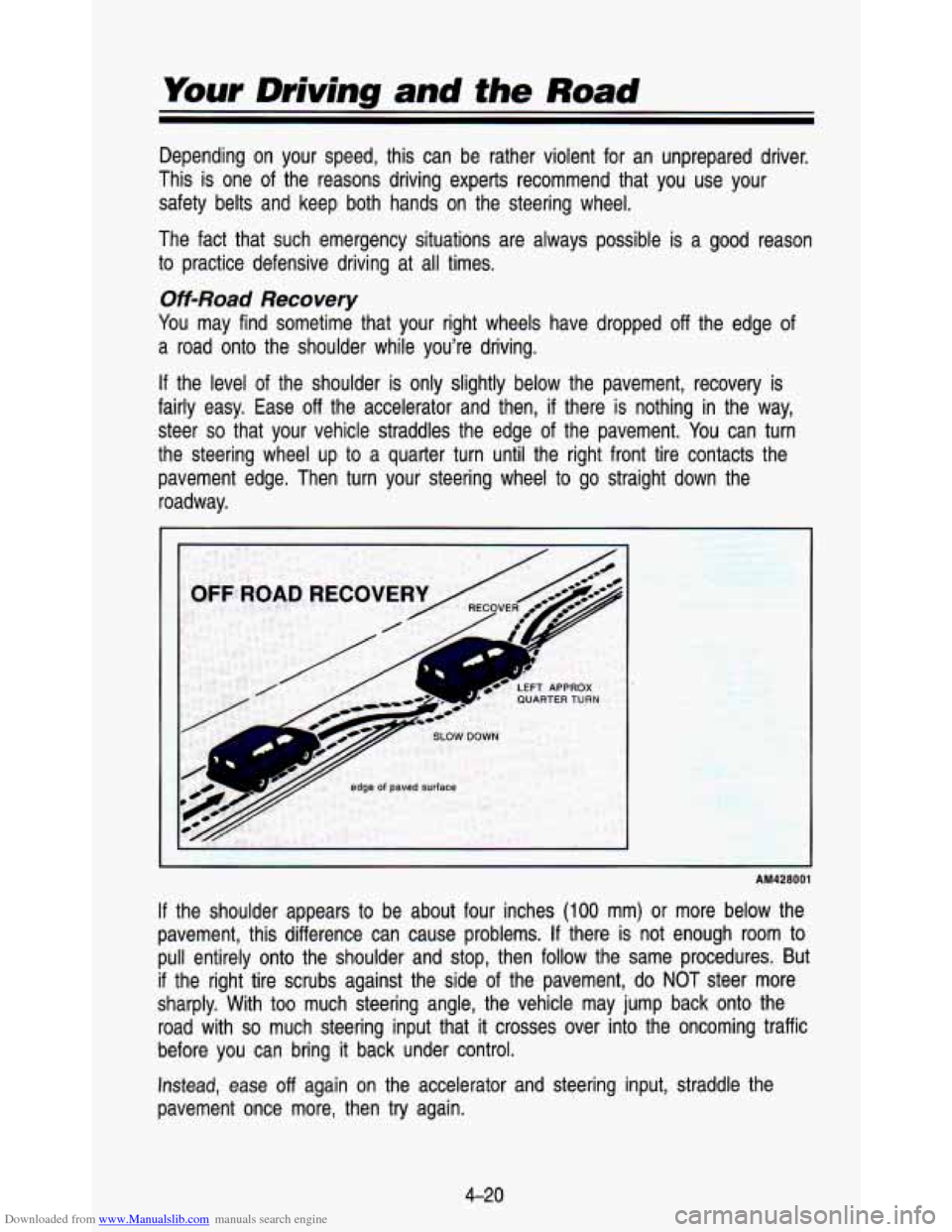
Downloaded from www.Manualslib.com manuals search engine Your Driving and the Road
Depending on your speed, this can be rather violent for an un\
prepared driver.
This is one of the reasons driving experts recommend that you use your
safety belts and keep both hands on the steering wheel.
The fact that such emergency situations are always possible is a good reason
to practice defensive driving at all times.
Off-Road Recovery
You may find sometime that your right wheels have dropped off the edge\
of
a road onto the shoulder while you’re driving.
If the level of the shoulder is only slightly below the pavement, recovery is
fairly easy. Ease off the accelerator and then, if there is nothing in the way,
steer
so that your vehicle straddles the edge of the pavement. You can turn
the steering wheel up to a quarter turn until the right front tire contacts the
pavement edge. Then turn your steering wheel
to go straight down the
roadway.
I
AM428001
If the shoulder appears to be about four inches (100 mm) or more below the
pavement, this difference can cause problems.
If there is not enough room to
pull entirely onto the shoulder and stop, then follow the same\
procedures. But
if the right tire scrubs against the side of the pavement, do NOT steer more
sharply. With too much steering angle, the vehicle may jump back onto the
road with
so much steering input that it crosses over into the oncoming traffic
before you can bring
it back under control.
Instead, ease off again on the accelerator and steering input, straddle the
pavement once more, then try again.
4-20
Page 176 of 345
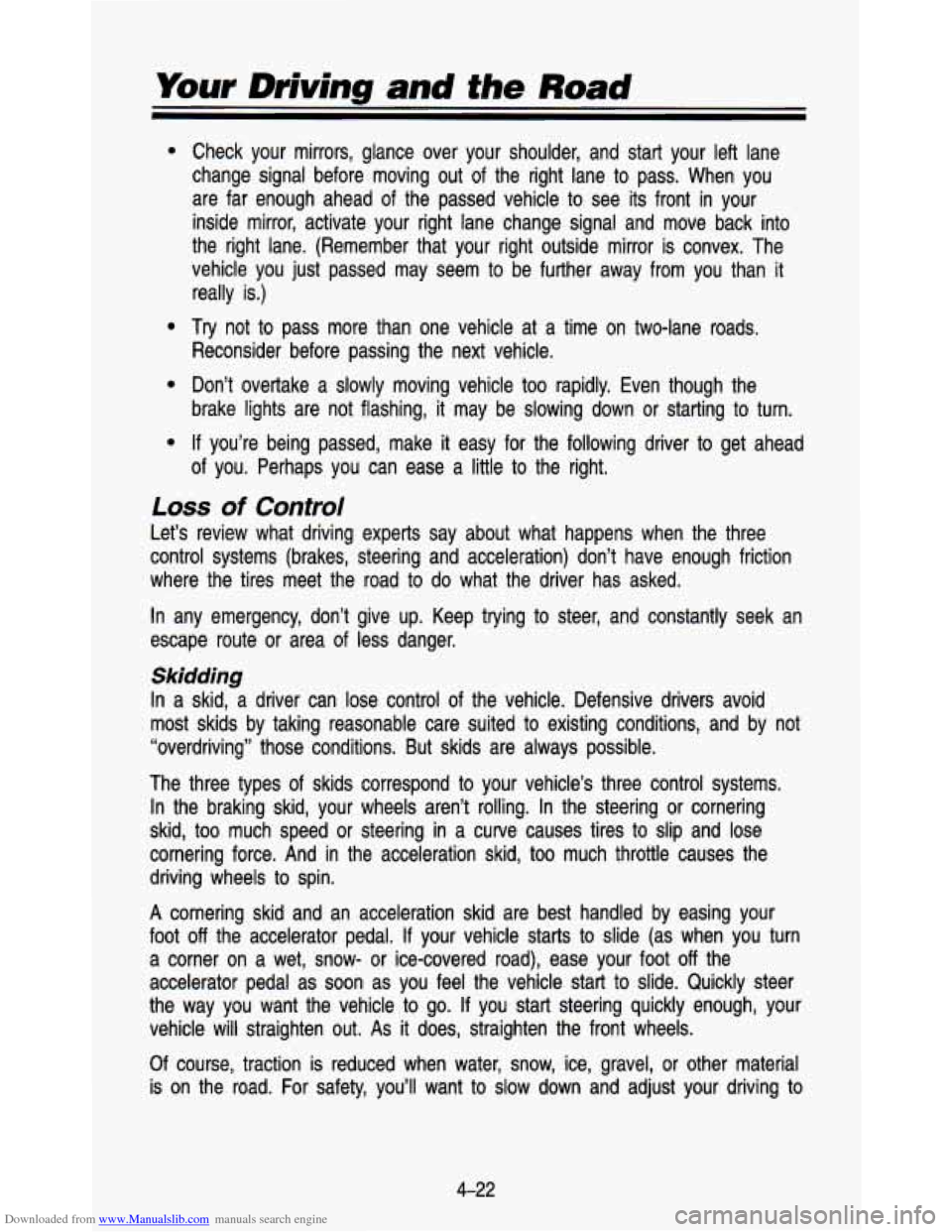
Downloaded from www.Manualslib.com manuals search engine Your Driving and the Road
0
Check your mirrors, glance over your shoulder, and start your \
left lane
change signal before moving out of the right lane
to pass. When you
are far enough ahead of the passed vehicle
to see its front in your
inside mirror, activate your right lane change signal and move \
back into
the right lane. (Remember that your right outside mirror is c\
onvex. The
vehicle you just passed may seem
to be further away from you than it
really
is.)
Try not to pass more than one vehicle at a time on two-lane roads.
Reconsider before passing the next vehicle.
Don’t overtake a slowly moving vehicle
too rapidly. Even though the
brake lights are not flashing, it may be slowing down or starting
to turn.
If you’re being passed, make it easy for the following driver
to get ahead
of you. Perhaps you can ease a little
to the right.
Loss of Control
Let’s review what driving experts say about what happens whe\
n the three
control systems (brakes, steering and acceleration) don’t ha\
ve enough friction
where the tires meet the road
to do what the driver has asked.
In any emergency, don’t give up. Keep trying
to steer, and constantly seek an
escape route or area of less danger.
Skidding
In a skid, a driver can lose control of the vehicle. Defensive drivers avoid
most skids by taking reasonable care suited to existing conditions, and by not
“overdriving” those conditions. But skids are always possib\
le.
The three types
of skids correspond to your vehicle’s three control systems.
In the braking skid, your wheels aren’t rolling. In the steering or cornering
skid,
too much speed or steering in a curve causes tires to slip and lose
cornering force. And in the acceleration skid,
too much throttle causes the
driving wheels
to spin.
A cornering skid and an acceleration skid are best handled by easing your
foot
off the accelerator pedal. If your vehicle starts to slide (as when you turn
a corner on a wet, snow- or ice-covered road), ease your foo\
t
off the
accelerator pedal
as soon as you feel the vehicle start to slide. Quickly steer
the way you want the vehicle
to go. If you start steering quickly enough, your
vehicle will straighten out.
As it does, straighten the front wheels.
Of course, traction is reduced when water, snow, ice, gravel, or other material
is on the road. For safety, you’ll want
to slow down and adjust your driving to
4-22